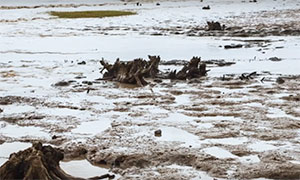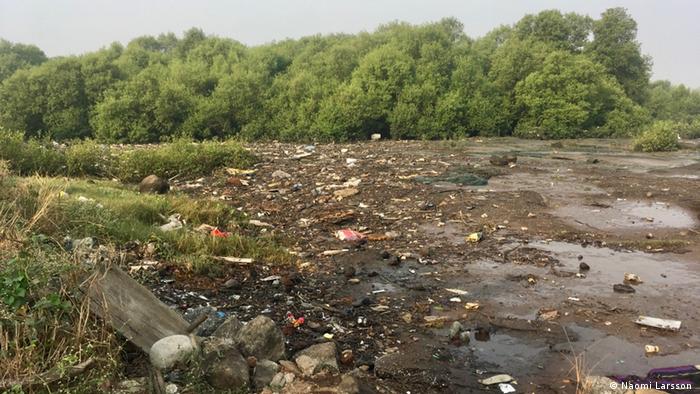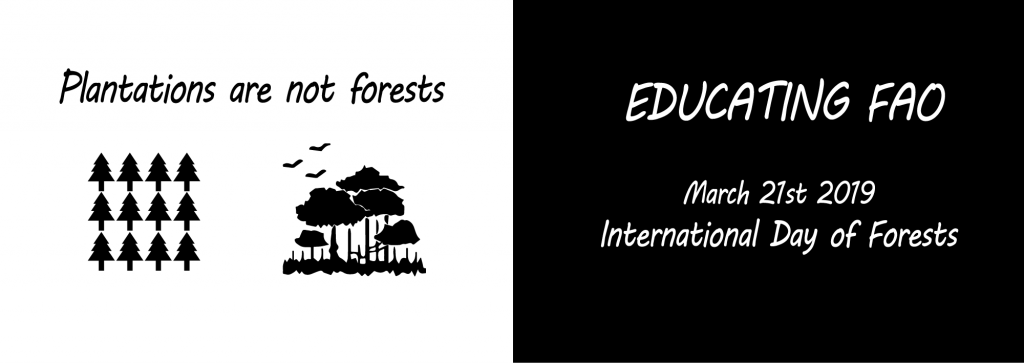FEATURE Restoring The Natural Mangrove Forest  USA – Coastal communities are intrinsically connected to the sea. Their lives depend on it. A key to happiness and life in tropical regions is a healthy mangrove forest. We are now recognizing that a world without the rainforests by the sea, wouldn’t just mean a dismal scenario for coastal communities, but would ultimately affect us all, and our planet. With the ability to store vast amounts of carbon, mangrove forests are key to tackling climate change, but they are under threat worldwide. The film takes us to the Andaman Coast in Southern Thailand, and explores the importance of mangrove forests. Much like the rest of Thailand, huge areas of mangroves were cut down during the 80s and 90s to make way for shrimp farms. And as mangrove destruction continues globally at nearly 1% annually, attempts are being made to restore these carbon-rich forests. We are introduced to Mangrove Action Project who have a unique approach to restoring mangrove forests; encouraging natural regeneration (ecological mangrove restoration), and collaborating with coastal communities (community-based restoration). The results show that these ideas and methods would have a great impact on any restoration project, and need to be implemented globally. VIEW VIDEO AFRICA ‘Seawater is coming into our farms and killing the plants’

TANZANIA – The water from the wells in Kisakasaka used to be so salty that it would turn people’s teeth yellow. Children, no matter how thirsty, would often refuse to drink. But with no other water source in this farming village near Zanzibar’s capital Stone Town, around 1,000 residents were forced to drink increasingly salty water that gave them headaches and nausea. “It was very difficult at the time and the children complained a lot about the water, but they had to drink it because there was no other option,” said Pili Issa Moussa, a mother-of-five and local resident. People’s problems were compounded when more and more crops started failing and animals started getting diseases as the seawater crept further inland and spoiled or washed away fertile soil. “There are some areas where even the coconut trees started to die,” said community leader Khatib Ali. The villagers formed a non-governmental organization to fight the effects of climate change and save their village from being battered by the winds and seawater advancing unimpeded due to the lack of tree barriers. READ MORE
ASIA
Rampal coal power plant, Bangladesh, an ethical perspective

INDIA – While the entire world is moving towards searching for the alternatives, especially renewable energy; Bangladesh India Friendship Power Company Ltd, is going to construct a 1,320 MW coal fired power plant near the Sundarbans in Rampal (located only 14 km apart from the world’s largest mangrove forest). The company is a joint venture between the state-run Bangladesh Power Development Board (BPDB), and India’s National Thermal Power Corporation (NTPC). While the government is electroplating any possible damage to the Sundarbans, a UNESCO world heritage site, the National Committee to Protect Oil, Gas, Mineral Resources, Power and Ports; some left-leaning organizations as well as environmentalists have been opposing that there will have numerous adverse impact on the pristine forest. READ MORE
Mangroves destruction in Maldives-islands’ biggest ecocide

MALDIVES – The decision to build a domestic airport in Kulhudhuffushi wetland and mangroves and the subsequent reclamation of a significant part of the mangroves is one of the biggest environmental ecocides the Maldives has seen in recent times. The destruction of the mangrove ecosystem commenced in October 2017, during President Yameen Abdul Gayoom’s administration despite a public outcry against this. The project has attracted criticism and attention not only from locals, civil society organizations and politicians based in the Maldives, but also from international organizations, foreign diplomats, international media and scientific and research-based organizations from abroad as well. Kulhdhuffushi Kulhi wetland and mangroves along with a belt of coastal vegetation running along the eastern edge of the island are the last remaining green space in this rapidly urbanizing island. READ MORE
Saving Mumbai's natural mangrove buffer against rising tides

INDIA – Crows pick at debris washed up on a shore in Mumbai. It's a humid day, and through thick smog, the outlines of gray buildings are just about visible on the other side of the inlet. In this part of Mumbai's mangrove forest, the land is barren, dotted with pools of dirty water and plastic waste. "There's so much dirtiness," says 19-year-old college student Kajal Jadhab, as she looks around at the trash. Scenes like this are common along Mumbai's shoreline. They were once covered in mangroves — coastal trees that act as vital flood defenses and carbon storage systems — but the forests have severely degraded, destroyed by encroaching housing developments and waste. Mumbai, India's second city, has lost around 40 percent of its mangrove forest cover in recent decades. Desolate areas like this are left behind, snapshots of the country's troubled relationship with the environment. READ MORE
North Jakarta sees growth of 32,000 mangrove trees

INDONESIA – North Jakarta has seen the growth of 32,000 trees since they were planted 10 years ago at the Ecomarine Mangrove Forest. The trees were planted on 1.8 hectares of land that was initially barren before it was converted into a forest on the edge of the Kali Adem Estuary in Muara Angke. “From 2008 until now, 32,000 mangrove trees have grown here,” said Muara Angke Mangrove Community head Muhammad Said as quoted by tempo.co on Wednesday. The mangrove trees include the pidada (Sonneratia), api-api (Avicennia), nipa palm (Nypa fruticans), and red mangrove (Rhizophora), Said explained. The trees were planted to recover the mangrove forest ecosystem along Jakarta's northern coast, which is threatened by land conversion. “There were mangroves, but in the 1990s they were wiped out due to the impact of development. In 2008, we established a mangrove community and started mangrove planting for the sake of caring for society and the environment,” he said. READ MORE
Sabah villagers struggle to save dwindling mangroves

MALAYSIA – At the Telaga river in Pitas, in the northern region of Sabah, villagers are fighting to save a once thriving mangrove forest which they say is teetering on the brink of destruction thanks to a shrimp park project in the area. A total of 2,300 acres of mangrove forest along the river has already been converted into shrimp ponds, with a further 1,000 acres earmarked for the park. The project came to a halt following protests mounted by the villagers and backed by NGOs. Mastupang Somoi, a farmer and fishermen who led the protests, said the initial damage to the mangrove forest was done in 2015. “The heavy machines came one night on a barge. They levelled the mangrove trees and dug a deep trench in the middle of the mangrove colony, cutting the brackish water supply to the trees. READ MORE
AMERICAS
Northward march of mangroves impacts fishing, flooding, carbon

USA – Walking along a wooden path winding through Nease Beachfront Park, Danny Lippi pointed to coastal trees sprouting from the shrubbery around him. The exotic species were brought here by warming temperatures — bringing business opportunities for the local arborist. “All of these are mangroves,” Lippi said, surrounded by the young perennial plants, blooming with hues of green and golden yellows. “You can actually see that line where the upland vegetation just stops.” Demand for Lippi’s mangrove trimming service has been growing as the trees have been accumulating northward, starting to block coastal views from Ormond Beach to Palm Coast. Their northernmost limit in the U.S. sits about 70 miles from St. Augustine on Amelia Island, and it continues to shift. Ranges of mangroves have naturally waxed and waned over the years, influenced by the weather, but with climate change has come a crucial reduction in crop- and tree-killing freeze events. The last freeze strong enough to wipe out mangroves took place in 1989. This decline in the number of frosts, coupled with intensifying storms spreading seed-like propagules, is causing the trees to push poleward. READ MORE
OCEANA
Why we should save the last scraps of nature

AUSTRALIA – Scientific thinking changes as new evidence comes to light. One vital new insight is the importance of saving even tiny, isolated remnants of native vegetation. Decades of research on fragmented habitats has shown that small, isolated patches of habitat are often ecologically depauperate — deficient in top predators and specialized old-growth species, and suffering from a wide variety of ecological woes. This research correctly shows the vital importance of protecting Earth’s vanishing wilderness areas. But such studies have also convinced some people that very small, isolated patches of native vegetation are nearly worthless. In many places, these tiny remnants are being bulldozed and razed to the ground. READ MORE
GLOBAL
Educating FAO: an urgent need! 2019 – International Day of Forests

GOLOBAL – In 2012, the UN General Assembly proclaimed March 21st the International Day of Forests. The aim: raising awareness about the importance of forests. The UN Food and Agriculture Organisation (FAO), the organizer of the Day, chose Forests and Education as the theme for 2019 and underlines the importance of investing in forest education. But what does FAO mean by “forest education”? Based on what World Rainforest Movement has learnt from communities, FAO ought to reflect on –at least- the following 10 points: 1. Plantations are NOT forests, FAO’s forest definition considers forests to be basically just “a bunch of trees”. This ignores the vital interconnections with other life forms. With this definition, FAO has actively promoted the establishment of many millions of hectares of industrial tree plantations, of mainly alien species, especially in the global South. 2. Forests cannot be reduced to forestry: The terms “Forestry” and “Forests” may sound similar and are sometimes used interchangeably, but they refer to very different things. Forestry reduces forests to their potential for wood production. Hence, FAO argues that you can “plant” forests. The reality is that it is only possible to plant trees. When FAO created a “Forestry department” (and not a Forest department) it shows that the “forestry” concept has priority in its policies. READ MORE LAST WORD  
Dear MAP Friends It is with sadness that I let you know that I recently lost a true friend, who has been at my side helping to edit the MAP News for more than 12 years now. Chuy was a fan of MAP, my Editor in Chief, and a faithful friend to those who work to make our planet a better place. He did just that, and he will be missed. He would have been 17 years old in Sept. Sincerely,
Sam Nugent
MAP News Editor Back to Top | 
Restoring The Natural Mangrove Forest
Watch movie 
Community Based Ecological Mangrove Restoration in Rufiji Delta VIEW VIDEO ACTION ALERT Halt further destruction of primary mangrove forests in the Maldives. We are urging you to write letters to the recently elected president of the Maldives and his environmental minister View Sample letter Save Pulau Kukup National Park – second largest mangrove island in the world. Sign The Petition Video: Mangroves for the Future – A look bacK. As the latest phase of Mangroves for the Future (MFF) draws to a close, this video highlights some of the project’s most successful initiatives – from local women supporting national park management in Viet Nam to an island in the Maldives that has become a model for waste management, and everything in between. View Here Making the case for Emergency Climate Change Action

Counting Mangroves

Placencia mangrove workshop teacher's poem Volunteer with MAP – LEARN MORE Watch Children's Mangrove Art Calendar Promo 2019 Click Here  
MAP 2019 Children’s Calendar available now CLICK HERE You can help ensure that the knowledge and skills needed to conserve and restore mangroves is preserved in coastal communities READ MORE WANT TO GET INVOLVED?
Follow and Join MAP!    


VOLUNTEER OPPORTUNITY
MANGROVE ISSUES Want to learn more about mangroves?
Our short presentation will give you a better understanding of the issues we are working to solve. WATCH PRESENTATION What is CBEMR? Easy to follow fact sheet – CLICK HERE What is EPIC? – The Ecosystems Protecting Infrastructure and Communities (EPIC) project: the role of ecosystems as protective barriers against climate induced hazards MANGROVES APP AVAILABLE
A pictorial field guide for easy identification of various mangrove species and learning about the mangroves ecosystem. CLICK HERE View MAP’s uploaded Videos at MAPmangrover’sChannel
Question Your Shrimp Consumer/Markets Campaign!
WATCH VIDEO Mangrove Restoration in Asia – Watch Short Video The Value of Mangrove Forests View Video CBEMR Experience Exchange MAP 2017 English Subtitles
VIEW THE VIDEO Mangroves: Guidebook to Malaysia – Click Here
Mangrove rehabilitation in Asia – Local Action and cross-border Transfer of Knowledge for the Conservation of Climate, Forests and Biodiversity VIEW VIDEOS HERE SHARE MAP'S VISION
CLICK HERE to watch short introductory video. Together we can work "at the roots of the sea". Our short documentary, Reducing the Risk of Disaster through Nature-Based Solutions : Mangroves

Exclusive Interview with Alfredo Quarto, Co-Founder and Executive Director of Mangrove Action Project – See more
Marvellous Mangroves Curriculum The Marvellous Mangroves Education Forum is an online hub for those utilizing the Marvellous Mangroves (MM) Curriculum. It gives students, teachers and anyone interested in mangroves, the opportunity to learn and share ideas themed around the curriculum, to connect and communicate with others around the globe whilst exploring mangroves from your computer or on the go. VISIT 
The award-winning Marvellous Mangroves (MM) curriculum educates children on the importance of mangroves and their ecological functions, teaching them about modern challenges and mechanisms for sustainability. VIEW VIDEO Marvellous Mangroves Curriculum in Bangladesh – WATCH VIDEO
MARVELLOUS MANGROVES IN BRAZIL
En Portuges 
Marvellous Mangroves – A Curriculum-Based Teachers Guide. FOR MORE ON MAPs AWARD WINNING CHINA MANGROVE CURRICULUM VISIT

VIMEO SHOW
VISIT OUR "MM" WEBPAGE Check out our presentation for more details on Marvellous Mangroves Read this 10 page history of the development of MAP’s educational curriculum VIEW DOCUMENT
Article in Canada's Green Teacher Magazine – Read More
Donate to MAP via Paypal
Giving could never be easier

It’s the action, not the fruit of the action, that's important. You have to do the right thing. It may not be in your power, may not be in your time, that there'll be any fruit. But that doesn't mean you stop doing the right thing. You may never know what results come from your action. But if you do nothing, there will be no result. —Mahatma Gandhi Green Planet Fundraising Assists MAP – LEARN MORE
Volunteer Opportunities with Mangrove Action Project CLICK HERE
"Question Your Shrimp" Campaign Question Your Shrimp- Don't Buy or Sell Imported Tropical Shrimp! Sign the Petition Learn more about the affects of the shrimp industry on mangroves by visiting our blog
Editor’s Note: Mangrove Action Project’s Executive Director, Alfredo Quarto was interviewed about shrimp by Green Acre Radio’s Martha Baskin
LISTEN TO INTERVIEW Information sheds clear light on shrimp-mangrove connection

SEE DETAILS MANGROVE/SHRIMP Sign the Consumer's Pledge to avoid imported shrimp
Not yet a MAP News subscriber?
Click here to subscribe. Note to Our Readers: We strive to keep active links in our newsletter. However, due to circumstances beyond our control, occasionally links to stories may become broken. If you find a link to a story is not functioning, please cut and paste the headline into your browser search bar. In most cases you should be able to locate the original story.
|






























